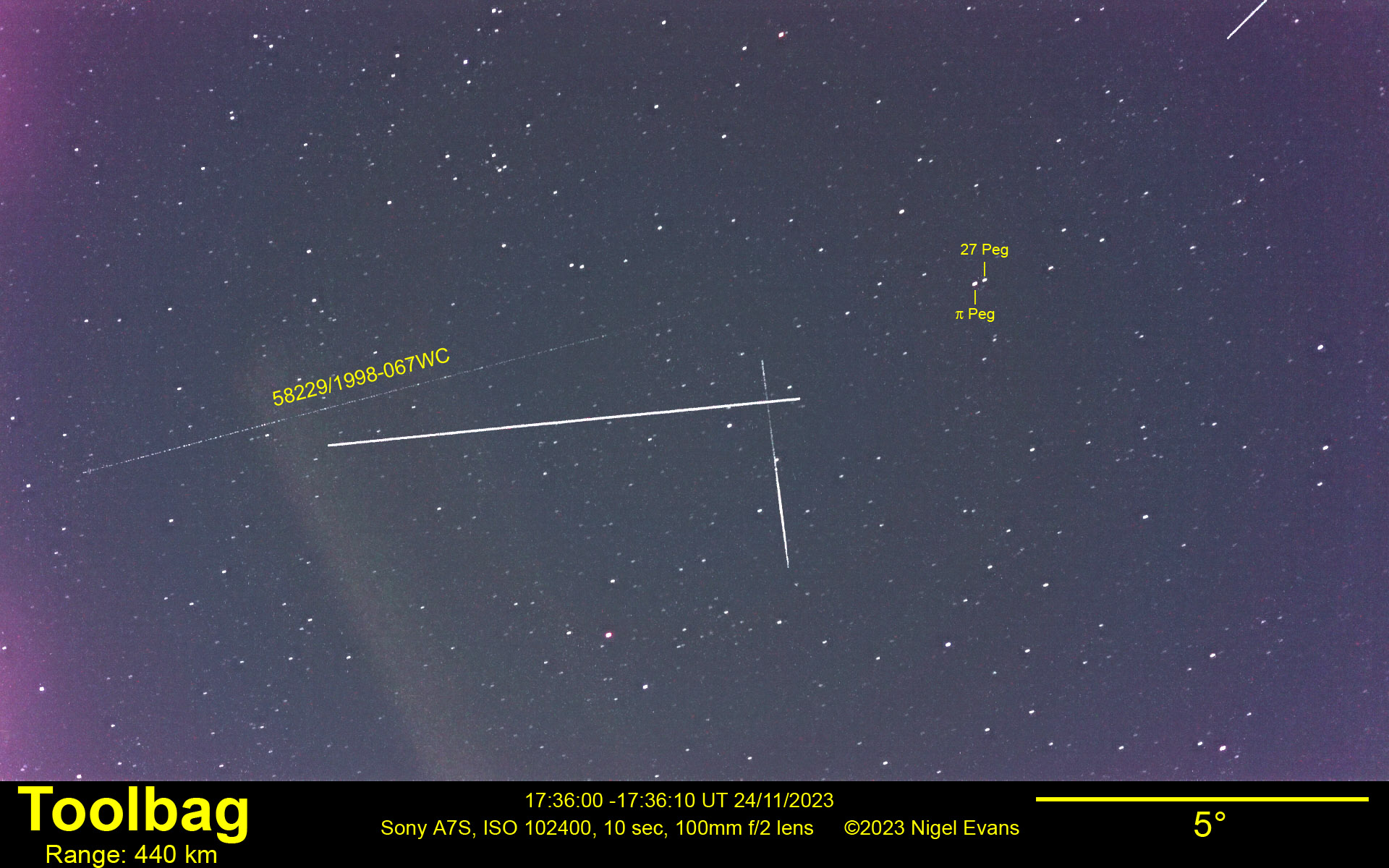
Orwell Astronomical Society (Ipswich)
Astronaut's Toolbag, 24-28 November 2023
The International Space Station (ISS) has been in the news following an incident during a spacewalk on 01 November 2023 when a toolbag was accidently released, drifted away, and entered an independent orbit from the ISS. The object presented one of the most unusual observing opportunities ever!
Fortunately, news stories provided the orbital identifier for the toolbag, 58229/1998-067WC, enabling its trajectory to be predicted. In late November, the ISS passed above the UK in early evenings. The toolbag was in a similar orbit, some four minutes ahead of the ISS, and just below naked eye visibility. On the evening of 24 November, a break in the weather over Suffolk presented an observing opportunity. Even so, conditions were not particularly promising, with patchy clouds and a gusty windy. A first quarter Moon illuminated the sky. The ISS was predicted to reach an altitude of 72° in Pegasus on its early evening pass.
To record an object in low Earth orbit I chose to use a Sony A7S in video mode, with a high ISO and the lens fully open, mounted on a static tripod. I set the camera recording while I searched with binoculars for the toolbag. I saw many candidates for the elusive toolbag, but concluded eventually that most were Starlink satellites.
The still image below shows a composite from 10 seconds of video footage. Very close to the predicted trajectory of the toolbag is a faint tumbling object, between magnitude 7 and 8. (There are three other satellite trails in the frame too.) The video below is formed from frames centred on the toolbag; the first segment shows the passage of the object among the stars at live rate; the second segment is a stacked version that runs at 5x live rate.
The obvious time to observe a satellite is when it is at greatest altitude, suffering least from atmospheric extinction. However, I noticed in the above video that the toolbag became brighter after it passed the point of greatest altitude. In general, in early evening, when a satellite is at its greatest altitude it is near first quarter, so not necessarily presenting the greatest surface area to reflect sunlight towards the observer. As a satellite moves in orbit beyond the observer towards the horizon, several factors affect its apparent brightness as seen by a camera:
On 28 November, I had another chance to observe the toolbag. The maximum altitude of the object on that night was 82° (in Cygnus), and I seized the opportunity to record it after greatest altitude with a variety of cameras. My results are below.
The following video shows the tool bag, at around magnitude 7, passing through the stars of Andromeda. (Only in the central portion of the recording shown here.) Nearby is another, brighter satellite. The camera used had a 50 mm, f1.8 lens at full aperture. This shows that the toolbag is easily detectable with a relatively small lens.
The following video, captured by a 100 mm f/2 camera at full aperture, shows the toolbag much more clearly, along with the variation in brightness as it tumbles. The video shows stars to magnitude 8. Below the video is a still capturing the variation in brightness.
The above still and two videos were captured by cameras on fixed tripods. The videos were reprocessed to centre on the toolbag.
In my observatory there is a 90 mm Megrez refractor. With the telescope following the motion of the stars, the toolbag appeared to rush through the field of view, as shown in the below video. Here the video captures stars to magnitude 10. The 1/30 second exposure of each frame does not arrest the motion of the object. Below the video is an annotated still.
Nigel Evans